
GINZA CONNECTIVE
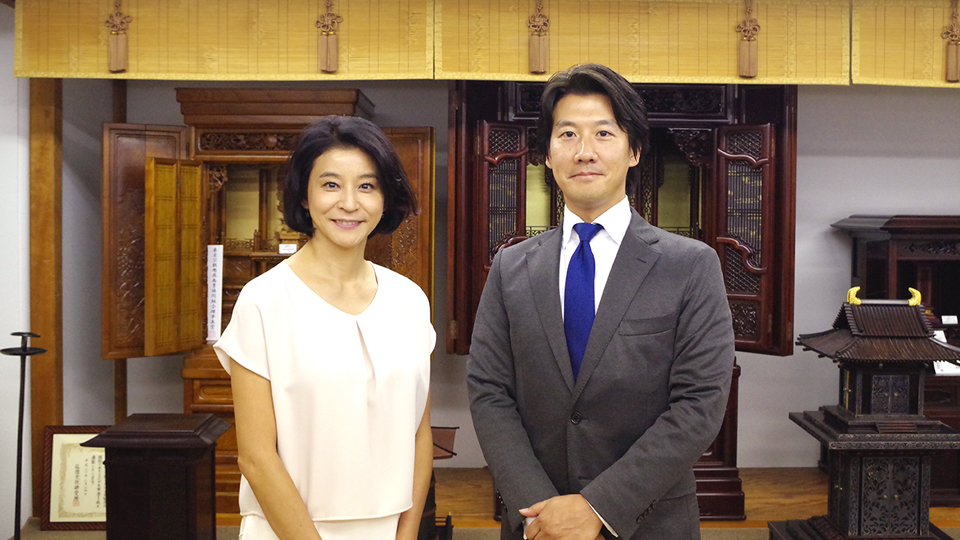
GINZA CONNECTIVE VOL.58
Motoyoshi Yasuda×Chisako Takashima
2016.09.06
An interview series featuring Ginza people in conversation with violinist Chisako Takashima. With a special fondness for Ginza, which holds many memories both from her professional and private lives, Takashima explores Ginza from various dimensions with her guests.In this volume, she welcomes Mr. Motoyoshi Yasuda, President and CEO of Yasuda-Shokeido, a long-established store founded in the Edo period, specializing in Buddhist family alters and articles.
Even as designs change, our prayers for the repose of a soul remain unchanged
- Takashima
- Would you say that making Buddhist family alters and articles has changed over the years? If so, could you please name some of the changes?
- Yasuda
- Conventional alters had a statelier design, with luxurious carvings in the ranma (fanlight) and shoji doors, but times have changed and people prefer more compact alters today. Many houses no longer have a Japanese-style room, so there is more demand for simple and modern design to fit in the living room as well as for alters that are easy to clean. We make alters using walnut and maple, as well.
- Takashima
- Especially in Tokyo, many people live in condominiums.
- Yasuda
- Yes, that is true. Also from a more emotional perspective, I feel that family alters have become a more personal item. Fundamentally, the inside of a Buddhist alter is supposed to be the “Pure Land” so we were not to place photos or any other objects that depicted the deceased while he was alive, but more people are placing photos or some of the ashes taken from the original urn in order to feel the presence of the deceased. Furthermore, some people offer bread and coffee instead of rice and tea, saying “the deceased was fond of it.” And I find no problem with these changes. What is important is that they are actions of love for the deceased.
- Takashima
- Sometimes, there are matters more important than customary practices. What has not changed?
- Yasuda
- Even with shifts in design and style as the times change, our “prayers for the repose of a soul” remain the same. We continue to care about the deceased and have a desire to properly hold memorial services on the first, second and other designated anniversaries of a loved one’s death.
- Takashima
- That is so true!
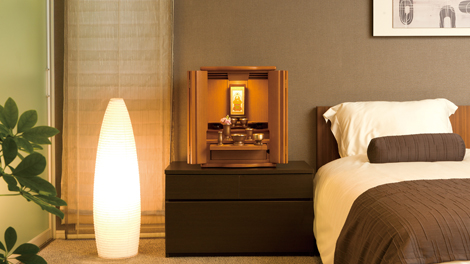
A modern Buddhist family alter
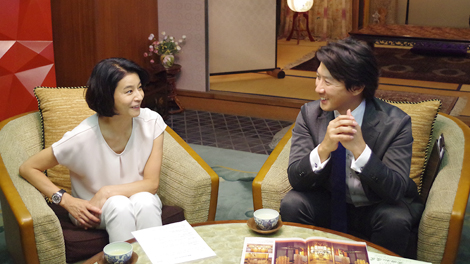
Seeking to offer omotenashi unique to Ginza, the “ultimate shopping street”
- Takashima
- I have been told that you are on the Board of Directors at Ginza Information Management.
- Yasuda
- Yes, I am also a member of G2020, a project that aims to make Ginza an even more attractive place with a view to the Tokyo Olympics Games.
- Takashima
- What kind of activities does the project involve?
- Yasuda
- We get together for discussions on branding Ginza and involving the entire Ginza community in local events.
- Takashima
- With an active role in town development, how do you feel about Ginza? Could you please share some of your personal ideas with me?
- Yasuda
- I believe Ginza to be the “ultimate shopping street”. Large department stores and small family-owned and -operated shops can coexist in Ginza, which attracts not only Japanese shoppers but also foreigners from many different countries. Ginza is unmatched in this sense. Having done business here for many years, my wish is that Ginza will always be able to offer all of our visitors omotenashi that is unique to this town. Ginza has become famous worldwide and we often see its name written out in Roman characters: GINZA. However, being a retailer of Buddhist alters, I find it awkward for us to print “GINZA” in our catalogues. I would like to pursue forms of omotenashi that meet the expectations of “銀座(Ginza)” written out in kanji characters.
- Takashima
- Do you receive many foreign customers as well?
- Yasuda
- We have recently had an increasing number of customers from overseas. Just the other day, a foreigner bought a lantern for Obon (=midsummer festival to welcome the spirits of ancestors). My guess is that it is going to be hung inside a home as an interior ornament. We appear to be Japanese gift shop from the outside (laughs).
- Takashima
- I see (laughs).
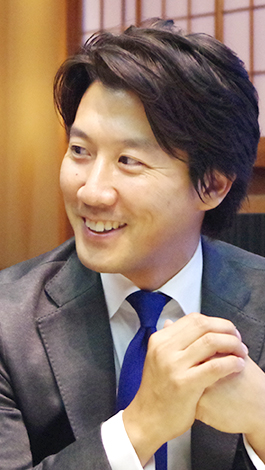
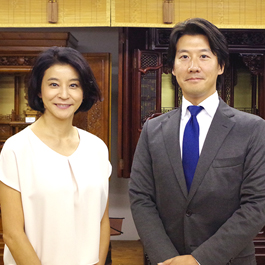
Chisako Takashima
Violinist. Takashima started taking violin lessons from the age of 6. After a successful career abroad, she moved her home base to Japan, where she currently performs in concerts across the country. Highly noted for her character in TV and radio appearances, she has currently opened up her career to more diverse fields with an unchanged focus on her profession
Chisako Takashima official websiteMotoyoshi Yasuda
President and CEO of Yasuda-Shokeido. Born in 1975 in Tokyo, he joined Wako Co., Ltd. after being graduated from university. After working for Ginza Wako for three years, he was trained at at a Buddhist alter and articles store in Kobe for 18 months before joining Yasuda-Shokeido. His favorite pastimes include shoe-polishing. He has always embraced a passion for taking care of plants and animals and currently enjoys bringing up his two children.
Written by Hiroko Yoda; Place of interview: Showroom at Yasuda-Shokeido Ginza Main Store
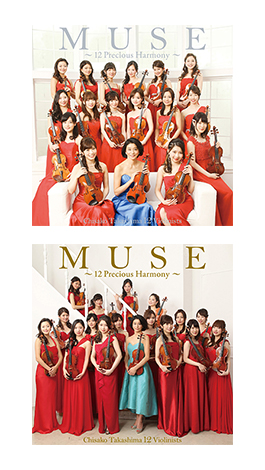
Released! A new album by Chisako Takashima 12 Violinists: MUSE -12 Precious Harmony-
Chisako Takashima 12 Violinists have released their first album in four years: MUSE -12 Precious Harmony-.
This diverse album celebrates the 12 Violinists’ tenth year with many classical numbers.
With three original pieces, including “SPLASH!!!,” a novel number written and co-performed by Sukimaswitch, the album comprises twelve numbers.
1 2
All List
- GINZA CONNECTIVE VOL.0 Ryo Sayegusa×Chisako Takashima
- GINZA CONNECTIVE VOL.1 Toshiyuki Kosaka×Chisako Takashima
- GINZA CONNECTIVE VOL.2 Yasuharu Mizuhara×Chisako Takashima
- GINZA CONNECTIVE VOL.3 Hitoshi Ishihara×Chisako Takashima
- GINZA CONNECTIVE VOL.4 Shinji Hara×Chisako Takashima
- GINZA CONNECTIVE VOL.5 Choichiro Motoyama×Chisako Takashima
- GINZA CONNECTIVE VOL.6 Noriko Okazoe×Chisako Takashima
- GINZA CONNECTIVE VOL.7 Choichiro Motoyama×Chisako Takashima
- GINZA CONNECTIVE VOL.8 Sayuri Yamaguchi×Chisako Takashima
- GINZA CONNECTIVE VOL.9 Yoshiki Tani×Chisako Takashima
- GINZA CONNECTIVE VOL.10 Yoshifumi Itoh×Chisako Takashima
- GINZA CONNECTIVE VOL.11 Kunihiko Miwa×Chisako Takashima
- GINZA CONNECTIVE VOL.12 Shin Watanabe×Chisako Takashima
- GINZA CONNECTIVE VOL.13 Akihiko Tsuda×Chisako Takashima
- GINZA CONNECTIVE VOL.14 Rie Horikawa×Chisako Takashima
- GINZA CONNECTIVE VOL.15 Jun Takahashi×Chisako Takashima
- GINZA CONNECTIVE VOL.16 Yusuke Harada×Chisako Takashima
- GINZA CONNECTIVE VOL.17 Lintaro Mizuhara×Chisako Takashima
- GINZA CONNECTIVE VOL.18 Keisuke Anzai×Chisako Takashima
- GINZA CONNECTIVE VOL.19 Hozu Yamamoto×Chisako Takashima
- GINZA CONNECTIVE VOL.20 Koji Shibata×Chisako Takashima
- GINZA CONNECTIVE VOL.21 Kayo Hosono×Chisako Takashima
- GINZA CONNECTIVE VOL.22 Mitsuru Saito×Chisako Takashima
- GINZA CONNECTIVE VOL.23 Akihisa Kawaguchi×Chisako Takashima
- GINZA CONNECTIVE VOL.24 Mamoru Sugiyama×Chisako Takashima
- GINZA CONNECTIVE VOL.25 Michiaki Kumagai×Chisako Takashima
- GINZA CONNECTIVE VOL.26 Shinichi Tanizawa×Chisako Takashima
- GINZA CONNECTIVE VOL.27 Koichi Suzuki×Chisako Takashima
- GINZA CONNECTIVE VOL.28 Munehito Matsuzaki×Chisako Takashima
- GINZA CONNECTIVE VOL.29 Hiroshi Hara × Chisako Takashima
- GINZA CONNECTIVE VOL.30 Shigeyuki Ando×Chisako Takashima
- GINZA CONNECTIVE VOL.31 Yukichi Ishikura × Chisako Takashima
- GINZA CONNECTIVE VOL.32 Seiko Yamada × Chisako Takashima
- GINZA CONNECTIVE VOL.33 Mami Nagai × Chisako Takashima
- GINZA CONNECTIVE VOL.34 Ryuta Takahashi × Chisako Takashima
- GINZA CONNECTIVE VOL.35 Kazumasa Osumi×Chisako Takashima
- GINZA CONNECTIVE VOL.36 Masahiro Kameoka×Chisako Takashima
- GINZA CONNECTIVE VOL.37 Shoichiro Watanabe×Chisako Takashima
- GINZA CONNECTIVE VOL.38 Keiji Niimoto×Chisako Takashima
- GINZA CONNECTIVE VOL.39 Chieko Nakamura ×Chisako Takashima
- GINZA CONNECTIVE VOL.40 Atsushi Yamane×Chisako Takashima
- GINZA CONNECTIVE VOL.41 Masaya Shibuya×Chisako Takashima
- GINZA CONNECTIVE VOL.42 Makoto Suzuki×Chisako Takashima
- GINZA CONNECTIVE VOL.43 Masaya Konaka×Chisako Takashima
- GINZA CONNECTIVE VOL.44 Masakazu Tanaka×Chisako Takashima
- GINZA CONNECTIVE VOL.45 Koko Kameoka × Chisako Takashima
- GINZA CONNECTIVE VOL.46 Jin Hirayama×Chisako Takashima
- GINZA CONNECTIVE VOL.47 Takashi Hoshihara×Chisako Takashima
- GINZA CONNECTIVE VOL.48 Mikiko Kimura × Chisako Takashima
- GINZA CONNECTIVE VOL.49 Keisuke Okamoto×Chisako Takashima
- GINZA CONNECTIVE VOL.50 Akira Ito × Chisako Takashima
- GINZA CONNECTIVE VOL.51 Tatsuhiko Adachi × Chisako Takashima
- GINZA CONNECTIVE VOL.52 Masahiko Yamano×Chisako Takashima
- GINZA CONNECTIVE VOL.53 Kiyoshi Kanazashi×Chisako Takashima
- GINZA CONNECTIVE VOL.54 Noriyuki Tsuji×Chisako Takashima
- GINZA CONNECTIVE VOL.55 Shoichi Kobayashi×Chisako Takashima
- GINZA CONNECTIVE VOL.56 Isao Nanjo×Chisako Takashima
- GINZA CONNECTIVE VOL.57 Shinobu Mitsuoka×Chisako Takashima
- GINZA CONNECTIVE VOL.58 Motoyoshi Yasuda×Chisako Takashima
- GINZA CONNECTIVE VOL.59 Toru Fujiki×Chisako Takashima
- GINZA CONNECTIVE VOL.60 Yuji Ida×Chisako Takashima
- GINZA CONNECTIVE VOL.61 Hitoshi Miki×Chisako Takashima
- GINZA CONNECTIVE VOL.62 Takehiko Furuya× Chisako Takashima
- GINZA CONNECTIVE VOL.63 Naoki Yoshizawa×Yusuke Yoshizawa×Chisako Takashima
- GINZA CONNECTIVE VOL.64 Kazuhito Kawase × Chisako Takashima
- GINZA CONNECTIVE VOL.65 Toshiji Yuki× Chisako Takashima
- GINZA CONNECTIVE VOL.66 Hikoyuki Yamaguchi×Chisako Takashima
- GINZA CONNECTIVE VOL.67 Daisuke Nagano×Chisako Takashima
- GINZA CONNECTIVE VOL.68 Shuichi Motohashi× Chisako Takashima
- GINZA CONNECTIVE VOL.69 Shinpei Tonaka×Chisako Takashima
- GINZA CONNECTIVE VOL.70 Shinya Kanematsu × Sachiko Takashima
- GINZA CONNECTIVE VOL.71 Masataka Yano×Chisako Takashima
- GINZA CONNECTIVE VOL.72 Mitsuhiro Kurokawa× Chisako Takashima
- GINZA CONNECTIVE VOL.73 Ryo Saegusa×Chisako Takashima








